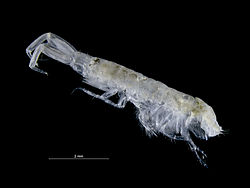| Monocorophium | |
|---|---|
 | |
| Monocorophium acherusicum | |
| Scientific classification | |
| Domain: | Eukaryota |
| Kingdom: | Animalia |
| Phylum: | Arthropoda |
| Class: | Malacostraca |
| Order: | Amphipoda |
| Family: | Corophiidae |
| Subfamily: | Corophiinae |
| Tribe: | Corophiini |
| Genus: | Monocorophium Bousfield & Hoover, 1997 |
Monocorophium is a genus of amphipod crustaceans.